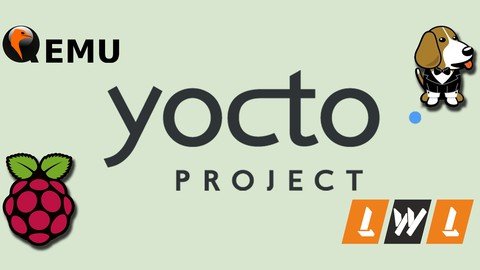
Genre: eLearning | MP4 | Video: h264, 1280×720 | Audio: aac, 44100 Hz
Language: English | SRT | Size: 2.67 GB | Duration: 4h 56m
What you’ll learn
Various operators used by bitbake: ?=, ??=, =, +=, =+, overriding style syntax, append operators
Create a layer: manual and automatic using bitbake-layers command
Create an image: from scratch and reuse an existing image
Image features: Debug tweaks, ssh server, read only root filesystem, splash screen etc
Image variables: IMAGE_FSTYPES, IMAGE_NAME etc
Various stages of recipes: fetch, configure, patch, compile etc
Recipes for C projects, Makefile based project and git repositories
Logging functions provided by bitbake
Requirements
Have a PC with internet connection
Should have completed Embedded Linux Using Yocto Part 1 Course (or) Should be aware of basics of Yocto
Description
Welcome to Embedded Linux using Yocto Part 2
Update: 11/10/2020: Added notes used in the course
What will you learn in this course
Various operators which are used by bitbake – ?=,??, =,+=, =+, overriding style syntax, append operators
Creating your own layer – Manual and Automatic
Creating your own image – scratch and reusing an existing image
Customizing image using IMAGE variables and IMAGE_FEATURES
Creating your own recipe – for C projects and git projects
Logging Functions provided by Yocto
Course Curriculum in Deep
Hour 1:
a) Various operators which are used by bitbake
b) Creating your own layer : Manually and Automatically through script
c) Verifying whether your layer is yocto compatible or not
Hour 2:
a) How to create our own custom image from scratch or reusing an existing image
b) Looked into various image features provided by core-image.bbclass such as debug-tweaks, selecting a ssh server, read only rootfs etc
c) Other customization variables related to image recipe
d) Manifest file which contains list of packages generated by the image
Hour 3:
a) Basics of Recipes
b) Important tasks performed by Bitbake in detail
c) Writing a recipe for simple hello world c program
d) Various Variables used in Recipe (WORKDIR, S, D, PN, PV, PR)
e) Explored the WORKDIR
Hour 4:
a) Log Files (Overall Log & Recipe Logs)
b) Bitbake Logging Functions
c) -D option of Bitbake
d) Makefile Recipe
Hour 5:
a) Automatically fetching the latest revision
b) Fetching a specific revision
c) Fetching a branch
d) Fetching a tag
e) Fetching a local repository
f) Applying Patch
This course comes with a 30 day money back guaranteed!. If you are not satisfied with the course, you’ll get your money back
So what are you waiting for, enroll now and take the next step in mastering Yocto Project
Who this course is for:
Developers who want to learn Yocto in deep
Password/解压密码0daydown
Download rapidgator
https://rg.to/file/b39512f755cb61f7a90f61d8148d5097/Embedded_Linux_Using_Yocto_Part_2.part1.rar.html
https://rg.to/file/5c11dad914b9671ad504b10ae97e96eb/Embedded_Linux_Using_Yocto_Part_2.part2.rar.html
https://rg.to/file/3b310071750caa5f4415554b991b8b67/Embedded_Linux_Using_Yocto_Part_2.part3.rar.html
Download nitroflare
https://nitroflare.com/view/8F3567AD818B05F/Embedded_Linux_Using_Yocto_Part_2.part1.rar
https://nitroflare.com/view/327FD7E5ED17384/Embedded_Linux_Using_Yocto_Part_2.part2.rar
https://nitroflare.com/view/ED8C1AFA97C2A1A/Embedded_Linux_Using_Yocto_Part_2.part3.rar